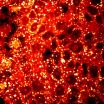(Press-News.org) Astronomers at the University of Washington have developed a new method of gauging the atmospheric pressure of exoplanets, or worlds beyond the solar system, by looking for a certain type of molecule.
And if there is life out in space, scientists may one day use this same technique to detect its biosignature — the telltale chemical signs of its presence — in the atmosphere of an alien world.
Understanding atmospheric pressure is key to knowing if conditions at the surface of a terrestrial, or rocky, exoplanet might allow liquid water, thus giving life a chance.
The method, devised by Amit Misra, a UW astronomy doctoral student, and co-authors, involves computer simulations of the chemistry of Earth's own atmosphere that isolate what are called "dimer molecules" — pairs of molecules that tend to form at high pressures and densities in a planet's atmosphere. There are many types of dimer molecules but this research focused only on those of oxygen.
Misra is first author of the paper was published in the February issue of the journal Astrobiology.
The researchers ran simulations testing the spectrum of light in various wavelengths. Dimer moleTcules absorb light in a distinctive pattern, and the rate at which they form is sensitive to the pressure, or density, in the planet's atmosphere.
"So the idea is that if we were able to do this for another planet, we could look for this characteristic pattern of absorption from dimer molecules to identify them," Misra said. The presence of such molecules, he said, likely means the planet has at least one-quarter to one-third the pressure of Earth's atmosphere.
Powerful telescopes soon to come online, such as the James Webb Space Telescope, scheduled for launch in 2018, may enable astronomers to use this method on distant exoplanets. With such enhanced tools, Misra said, astronomers might detect dimer molecules in actual exoplanet atmospheres, leading to a clear understanding of the planet's atmosphere.
This research may also play a part in the greatest astronomical quest of all — the ongoing search for life in the cosmos.
That's because the team realized along the way that oxygen dimer molecules are often more detectable in an atmosphere than other markers of oxygen. That's important from a biological standpoint, Misra said.
"It's tied to photosynthesis, and we have pretty good evidence that it's hard to get a lot of oxygen in an atmosphere unless you have algae or plants that are producing it at a regular rate.
"So if we find a good target planet, and you could detect these dimer molecules — which might be possible within the next 10 to 15 years — that would not only tell you something about pressure, but actually tell you that there's life on that planet."
INFORMATION:
Misra's UW co-author is Victoria Meadows, professor of astronomy; other co-authors are Mark Claire of Scotland's University of St. Andrews and Dave Crisp of NASA's Jet Propulsion Laboratory in Pasadena, Calif.
The research was performed through the UW-based Virtual Planetary Laboratory and funded by NASA (Grant NNH05ZDA001C), as well as a grant from Advancing Science in America, Seattle chapter.
For more information, contact Misra at 440-554-6514 or amit0@u.washington.edu.
'Dimer molecules' aid study of exoplanet pressure, hunt for life
2014-03-04
ELSE PRESS RELEASES FROM THIS DATE:
Cholesterol study suggests new diagnostic, treatment approach for prostate cancer
2014-03-04
WEST LAFAYETTE, Ind. - Researchers have discovered a link between prostate cancer aggressiveness and the accumulation of a compound produced when cholesterol is metabolized in cells, findings that could bring new diagnostic and treatment methods.
Findings also suggest that a class of drugs previously developed to treat atherosclerosis might be repurposed for treatment of advanced prostate cancer.
The research showed depletion of the compound cholesteryl ester significantly reduced prostate cancer cell proliferation, impaired its ability to invade a laboratory tissue ...
Young children form first impressions from faces
2014-03-04
Just like adults, children as young as 3 tend to judge an individual's character traits, such as trustworthiness and competence, simply by looking at the person's face, new research shows. And they show remarkable consensus in the judgments they make, the findings suggest.
The research, led by psychological scientist Emily Cogsdill of Harvard University, shows that the predisposition to judge others based on physical features starts early in childhood and does not require years of social experience. The study is published in Psychological Science, a journal of the Association ...
Research connects drug war violence in Mexico with desensitization in social media
2014-03-04
Amid times of crisis, citizens often turn to social media as a method to share information, make observations and vent. But as a Georgia Tech professor's research into social media use amid the Mexican drug war shows, posts can reveal growing numbness, or desensitization, during times of protracted violence and stress.
Munmun De Choudhury, formerly of Microsoft Research and now an assistant professor in the School of Interactive Computing at Georgia Tech, led the research. Her team's paper, "'Narco' Emotions: Affect and Desensitization in Social Media during the Mexican ...
Spiral galaxy spills blood and guts
2014-03-04
This new Hubble image shows spiral galaxy ESO 137-001, framed against a bright background as it moves through the heart of galaxy cluster Abell 3627. This cluster is violently ripping the spiral's entrails out into space, leaving bright blue streaks as telltale clues to this cosmic crime.
This new Hubble image shows ESO 137-001, a galaxy located in the southern constellation of Triangulum Australe (The Southern Triangle) -- a delicate and beautiful spiral galaxy, but with a secret.
This image not only captures the galaxy and its backdrop in stunning detail, but also ...
Bright pulses of light could make space veggies more nutritious, says CU-Boulder study
2014-03-04
Exposing leafy vegetables grown during spaceflight to a few bright pulses of light daily could increase the amount of eye-protecting nutrients produced by the plants, according to a new study by researchers at the University of Colorado Boulder.
One of the concerns for astronauts during future extended spaceflights will be the onslaught of eye-damaging radiation they'll be exposed to. But astronauts should be able to mitigate radiation-induced harm to their eyes by eating plants that contain carotenoids, especially zeaxanthin, which is known to promote eye health.
Zeaxanthin ...
New evidence confirms link between IQ and brain cortex
2014-03-04
Rate of change in the thickness of the brain's cortex is an important factor associated with a person's change in IQ, according to a collaborative study by scientists in five countries including researchers at the Montreal Neurological Institute and Hospital – The Neuro, at McGill University and the McGill University Health Centre. The study has potentially wide-ranging implications for the pedagogical world and for judicial cases in which the defendant's IQ score could play a role in determining the severity of the sentence.
The cortex is the thin, outermost layer of ...
Drinking buddies deny copying alcoholic drink orders
2014-03-04
LIVERPOOL, UK – 5 March 2014: People who copy their friend's drinking behaviour will deny that their decision has been influenced, researchers at the University of Liverpool have shown.
A new study, conducted in the University of Liverpool's bar laboratory, a lab designed to imitate a bar, brought together pairs of friends. One of the friends was made aware of the experimental aims and was told to drink alcoholic drinks throughout the session or to stick to soft drinks.
While most people were strongly influenced by peers – they mimicked their friend and drank more ...
Silk-based surgical implants could offer a better way to repair broken bones
2014-03-04
MEDFORD/SOMERVILLE, MASS. AND BOSTON -- When a person suffers a broken bone, treatment calls for the surgeon to insert screws and plates to help bond the broken sections and enable the fracture to heal. These "fixation devices" are usually made of metal alloys.
But metal devices may have disadvantages: Because they are stiff and unyielding, they can cause stress to underlying bone. They also pose an increased risk of infection and poor wound healing. In some cases, the metal implants must be removed following fracture healing, necessitating a second surgery. Resorbable ...
New markers for acute kidney injury reported
2014-03-04
LOUISVILLE, Ky. – Saeed A. Jortani, Ph.D., associate clinical professor in the University of Louisville's Department of Pathology and Laboratory Medicine, headed up one of three labs in the United States involved in determining two new markers for acute kidney injury (AKI). The research group's paper, "Validation of Cell-Cycle Arrest Biomarkers for Acute Kidney Injury Using Clinical Adjudication," was posted online Feb. 25 by the American Journal of Respiratory and Critical Care Medicine.
AKI has been difficult to diagnose and treat early because current markers for ...
Reduced ignition propensity requirement may cause changes to cigarette smoke chemistry
2014-03-04
Scientists have created temperature maps to explain how reduced ignition propensity (RIP) bands influence cigarette burn rate and possibly the chemical composition of the resulting smoke.
RIP bands are designed to make a cigarette go out if it is not being actively smoked. Previous studies have shown a significant increase in levels of biomarkers for a few polycyclic aromatic hydrocarbons (PAHs) in smokers of RIP cigarettes, although the toxicological implications of these increases are currently unknown (June et al. Tobacco Induced Diseases 2011, 9:13).
RIP bands are ...


